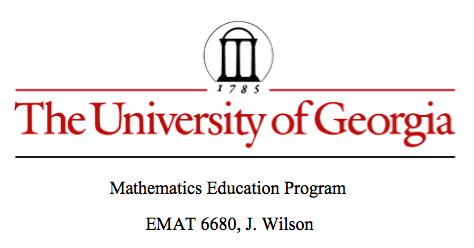

Assignment 6
Ratios and Relationships
of a triangle and the triangle formed from its medians
By
Megan Dickerson
The first thing that I did to examine the relationship and ratios between a triangle and the triangle formed by its medians, was to find the triangle formed by its medians.
Create any triangle ABC and find its medians.

To create the triangle formed by the 3 medians (colored red, blue, and green), label a point and create a line parallel to a median. Then create a circle with the point as the center and the median as the radius. This construction will give you a side equal to one of the medians of the original triangle. Do this 3 times (for each median) and a new triangle with sides equal to the medians of the original will be created.

Now to examine all of the relationships and ratios of sides, area, and perimeter, I found the measures for all the sides, the area of both triangles, the perimeter of both triangles, and the ratios of area and perimeter of both triangles.

I saw immediately that the areas of the 2 triangles were not congruent and the perimeter of the triangles were not congruent.
Then I looked at the ratios of all of the sides, and found no relationship there.
In order to examine the ratio of areas and ratio of perimeters I need another set of triangles.



Once again the sides of these 2 triangles have no relationship when the ratios are examined, and the areas and perimeter are not congruent. However when I looked at the ratio of the 2 areas, I discovered that the ratio was the same as the last set of triangles.
I then animated point on Triangle ABC and saw that the ratio of the area of the original triangle/the area of the triangle formed by medians is always 1.33 or 4/3.
Now, I want to prove that this is always the case.
I started out with a fresh triangle (ABC). Then to create the triangle formed by the medians of triangle ABC, I translated the median BF so that it starts at D. DG is parallel and congruent in length to BF. Similarly, median AE was translated to start at C. SO, AE is parallel and congruent to GC. Now, Triangle DGC is formed from the median of the original Triangle ABC.

The area I have highlighted in blue is one half of the area of Triangle DGC, and 3/4 of a half of the area of Triangle ABC. To prove this look at the next picture.

Now, Triangle ADC is equal to half the area of Triangle ABC since DC is a median for Triangle ABC. Triangle DHC is equal to half of the area of Triangle DGC since H is a midpoint of DG, making HC a median of Triangle DGC. H is proven to be a midpoint by looking at parallelogram AGFD. In this parallelogram the 2 diagonals bisect each other, so DH is congruent to HG.
The yellow triangle (Triangle ADH) is 1/4 the area of of Triangle ADC. AH is proven to be 1/4 the length of base AC of Triangle ADC since DH and BF are parallel, and Triangle ADH and Triangle ADC have the same altitude, so Triangle ADH is equal to 1/4 the area of Triangle ADC.
This proves that the green triangle (Triangle DHC) is equal to 1/2 the area of Triangle DGC (triangle formed by medians), and 3/4 of 1/2 of Triangle ABC ( 3/8 of Triangle ABC). So, 3/8 of Triangle ABC = 1/2 of Triangle DGC
Multiply both sides by 2 and you get, 3/4 of Triangle ABC = Triangle DGC.
This can also be written as Triangle ABC = 4/3 of Triangle DGC
So the ratio is 4/3 or approximately 1.33.